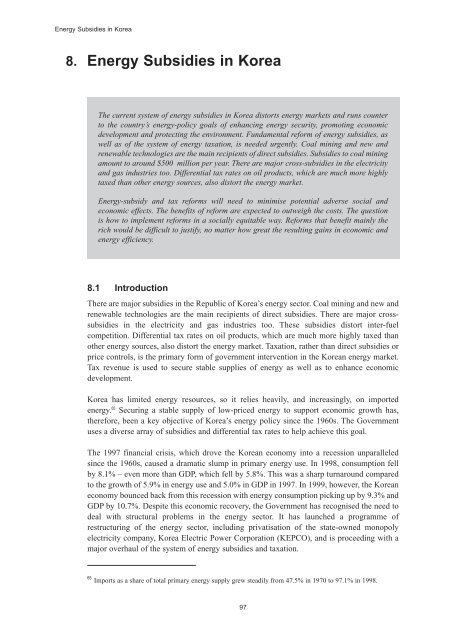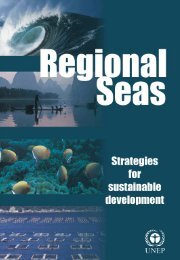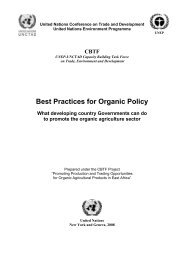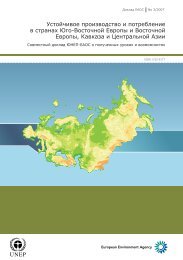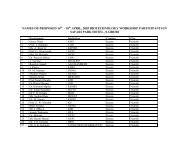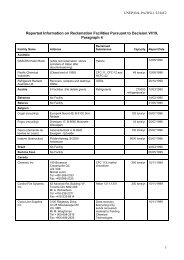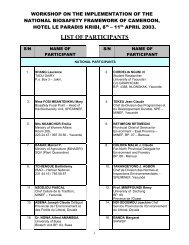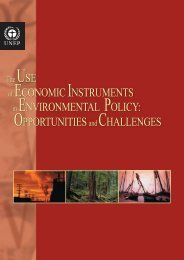Energy Subsidies: Lessons Learned in Assessing their Impact - UNEP
Energy Subsidies: Lessons Learned in Assessing their Impact - UNEP
Energy Subsidies: Lessons Learned in Assessing their Impact - UNEP
Create successful ePaper yourself
Turn your PDF publications into a flip-book with our unique Google optimized e-Paper software.
<strong>Energy</strong> <strong>Subsidies</strong> <strong>in</strong> Korea<br />
8. <strong>Energy</strong> <strong>Subsidies</strong> <strong>in</strong> Korea<br />
The current system of energy subsidies <strong>in</strong> Korea distorts energy markets and runs counter<br />
to the country’s energy-policy goals of enhanc<strong>in</strong>g energy security, promot<strong>in</strong>g economic<br />
development and protect<strong>in</strong>g the environment. Fundamental reform of energy subsidies, as<br />
well as of the system of energy taxation, is needed urgently. Coal m<strong>in</strong><strong>in</strong>g and new and<br />
renewable technologies are the ma<strong>in</strong> recipients of direct subsidies. <strong>Subsidies</strong> to coal m<strong>in</strong><strong>in</strong>g<br />
amount to around $500 million per year. There are major cross-subsidies <strong>in</strong> the electricity<br />
and gas <strong>in</strong>dustries too. Differential tax rates on oil products, which are much more highly<br />
taxed than other energy sources, also distort the energy market.<br />
<strong>Energy</strong>-subsidy and tax reforms will need to m<strong>in</strong>imise potential adverse social and<br />
economic effects. The benefits of reform are expected to outweigh the costs. The question<br />
is how to implement reforms <strong>in</strong> a socially equitable way. Reforms that benefit ma<strong>in</strong>ly the<br />
rich would be difficult to justify, no matter how great the result<strong>in</strong>g ga<strong>in</strong>s <strong>in</strong> economic and<br />
energy efficiency.<br />
8.1 Introduction<br />
There are major subsidies <strong>in</strong> the Republic of Korea’s energy sector. Coal m<strong>in</strong><strong>in</strong>g and new and<br />
renewable technologies are the ma<strong>in</strong> recipients of direct subsidies. There are major crosssubsidies<br />
<strong>in</strong> the electricity and gas <strong>in</strong>dustries too. These subsidies distort <strong>in</strong>ter-fuel<br />
competition. Differential tax rates on oil products, which are much more highly taxed than<br />
other energy sources, also distort the energy market. Taxation, rather than direct subsidies or<br />
price controls, is the primary form of government <strong>in</strong>tervention <strong>in</strong> the Korean energy market.<br />
Tax revenue is used to secure stable supplies of energy as well as to enhance economic<br />
development.<br />
Korea has limited energy resources, so it relies heavily, and <strong>in</strong>creas<strong>in</strong>gly, on imported<br />
energy. 65 Secur<strong>in</strong>g a stable supply of low-priced energy to support economic growth has,<br />
therefore, been a key objective of Korea’s energy policy s<strong>in</strong>ce the 1960s. The Government<br />
uses a diverse array of subsidies and differential tax rates to help achieve this goal.<br />
The 1997 f<strong>in</strong>ancial crisis, which drove the Korean economy <strong>in</strong>to a recession unparalleled<br />
s<strong>in</strong>ce the 1960s, caused a dramatic slump <strong>in</strong> primary energy use. In 1998, consumption fell<br />
by 8.1% – even more than GDP, which fell by 5.8%. This was a sharp turnaround compared<br />
to the growth of 5.9% <strong>in</strong> energy use and 5.0% <strong>in</strong> GDP <strong>in</strong> 1997. In 1999, however, the Korean<br />
economy bounced back from this recession with energy consumption pick<strong>in</strong>g up by 9.3% and<br />
GDP by 10.7%. Despite this economic recovery, the Government has recognised the need to<br />
deal with structural problems <strong>in</strong> the energy sector. It has launched a programme of<br />
restructur<strong>in</strong>g of the energy sector, <strong>in</strong>clud<strong>in</strong>g privatisation of the state-owned monopoly<br />
electricity company, Korea Electric Power Corporation (KEPCO), and is proceed<strong>in</strong>g with a<br />
major overhaul of the system of energy subsidies and taxation.<br />
65 Imports as a share of total primary energy supply grew steadily from 47.5% <strong>in</strong> 1970 to 97.1% <strong>in</strong> 1998.<br />
97


